Online Magazine
& Cooking Club

In This Issue
Feature Articles
Making heads & tails of
the squash kingdom
6 Tricks to Take the Bland
out of Summer Squash
Zucchini Overload:
how to turn over-
into advantage
5 Fast Ways to Cook Squash +
5 Simple Ways to Dress It Up
In Every Issue
Why We Love It
Top 10 Questions about Squash
The Green Kitchen
Picky Eater Tips
Money Saving Tricks
News from the Farm


Cooking School
Cooking Classes:
Greek Potato Salad
Zucchini Salad Americana
Buying the Best
Storing for Flavor
Prepping Tricks & Tips
Cooking Basics
Recipes, Recipes, Recipes
14 Easy, Creative Dishes Using Summer Squash



















<<In the Kitchen: Prepping Tips
An “Easy-
Prepping: The Basics
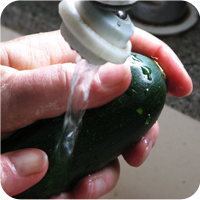

1. Wash
Rub off dirt or debris with your hands. Squash’s tender skin would get scratched by a vegetable scrubber.

Peeling: Not Required A lot of nutrients are found in the skin, plus it’s the source of squash’s gorgeous color! The only exception: Squash that didn’t get picked before it’s skin started hardening must be lightly peeled or it will taste leathery, even if well-
Seeding : Not Required Summer squash seeds are generally small and tender enough to be eaten as part of the squash. However, if a squash has gotten very large or old, its seeds may be too hard and large for comfortable eating. See below for instruction on scooping them out along with any of the pulp that has turned stringy or spongy.
Sliver Testing: Required Every now and then, a squash will be bitter, even if other squash in the same batch taste fine. While it doesn’t happen often, the consequences are awful: One bitter zucchini renders an entire dish unpleasant with random bursts of bitterness. So get in the tasting habit. Slice a sliver off the end of each squash and taste for any kind of bitterness, harshness or even just a complete absence of taste.
4 Easy Steps for Prepping Summer Squash
No need to cut off more than
¼ to ½ inch.
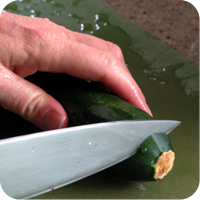

2. Slice Off Ends
See below for specific cutting instructions.
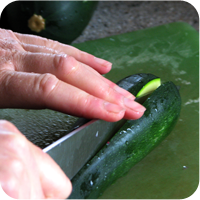
Taste a small sliver of each squash to ensure it isn’t bitter or harsh.
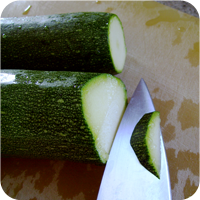

3. Test

4. Cut

Slicing
Pic
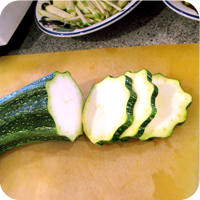

Matchsticks, Dicing and Cubing
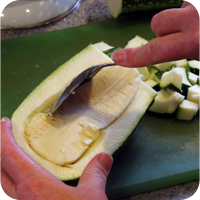

Large Squash...

Slicing into “Slabs”

Odd-
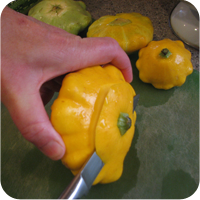

Shredding
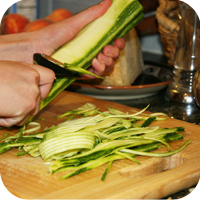

Julienning
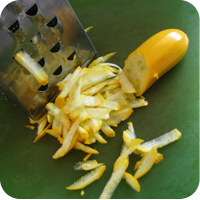
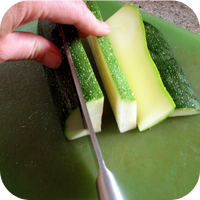
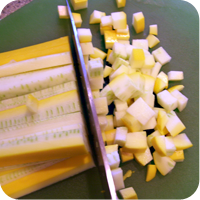
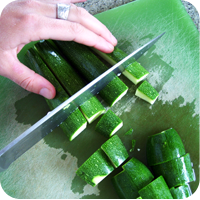









© 2009 Culinary Concepts, Inc., Boulder CO


Have Some Fun Everyday cooks may wonder whether it makes any difference if they, for example, julienne a squash rather than simply slice it. Logically speaking, the answer is “no;” a squash’s basic surface taste will be the same. But I have found that “taste” has other, more subtle dimensions that are affected by how a vegetable is cut.
Most importantly, there is “mouth feel.” When a vegetable is cut in a shape and size similar to the other vegetables and ingredients in a dish, like in the Mexican Layered Casserole to the right, there is a better chance 1) that each forkful will contain some of each ingredient and 2) that chewing will release the flavor of each ingredient in a balanced chorus.
Then there is “exposure.” Cutting methods that expose more of a vegetable’s surface area allow it to both give more flavor to the dish and receive more in return.
With nothing to lose, it’s worth experimenting. Click on any of the pictures below for step-
The onions, green pepper and yellow zucchini are diced into 1/2” cubes to compliment the bits of hamburger that are the center point of this Mexican Layered Casserole.
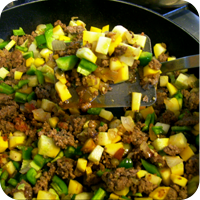

Although the recipe for BBQ Chicken Pasta calls for a matchstick cut, slices will work just fine if you’re in a hurry.
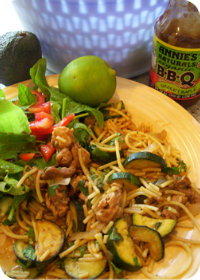

Helpful Hints:

Next Page

Prev Page